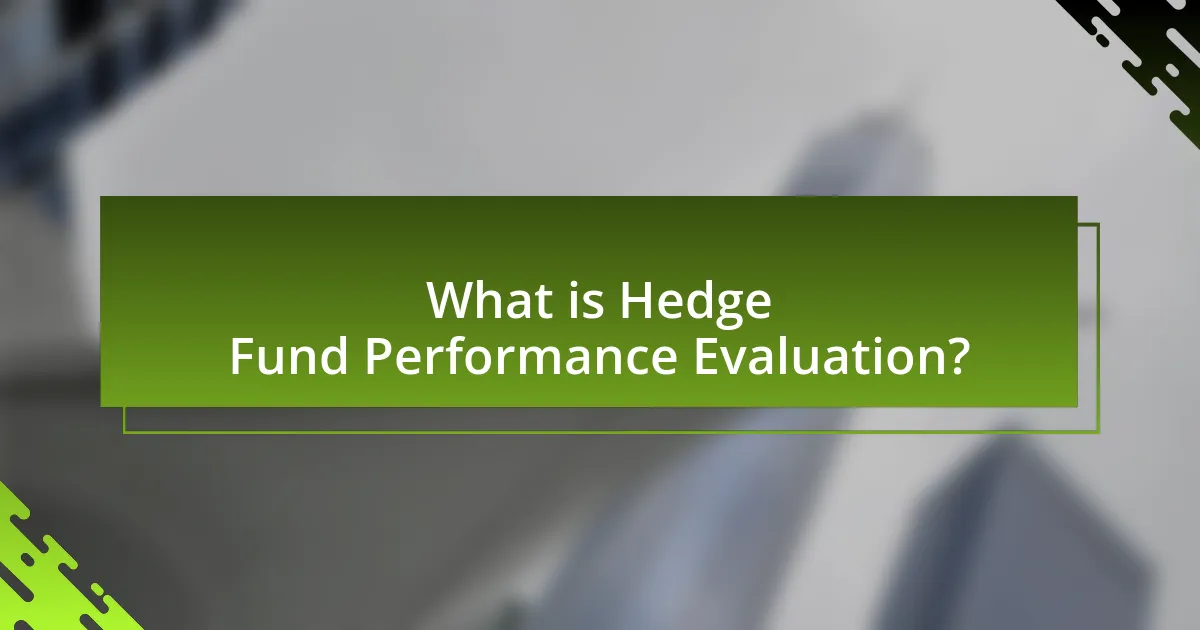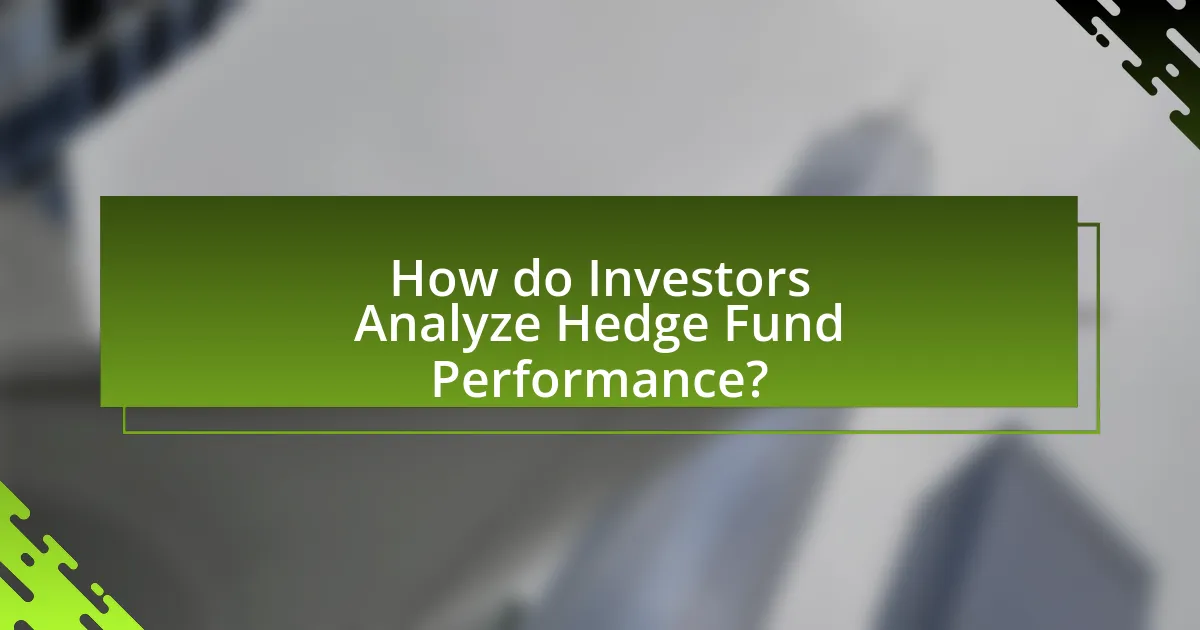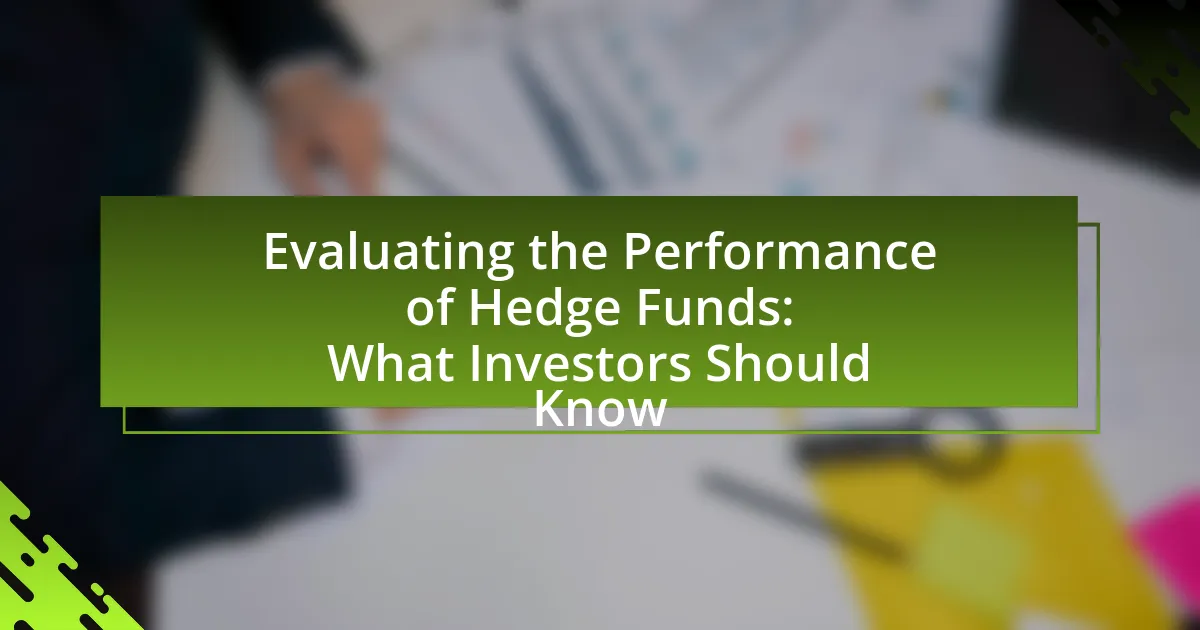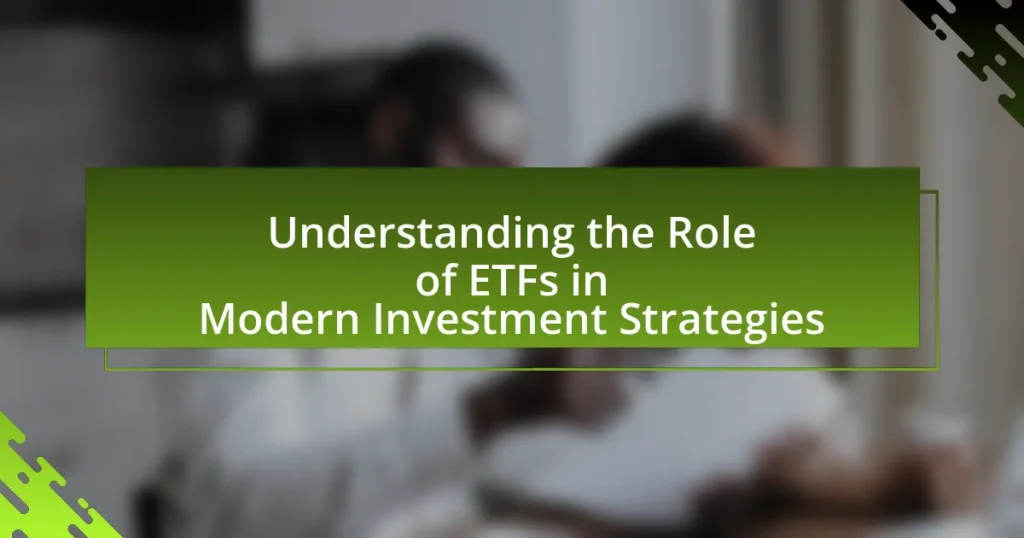Hedge fund performance evaluation is a critical process for investors, focusing on assessing returns relative to risk and investment strategies. This article outlines the importance of performance evaluation, highlighting key metrics such as alpha, beta, and the Sharpe ratio, which help investors make informed decisions. It discusses the challenges faced in evaluating hedge funds, including data transparency and the impact of fees, while also emphasizing the role of fund management and market conditions in performance outcomes. Additionally, the article provides practical tips for conducting thorough due diligence and avoiding common pitfalls in hedge fund evaluations.

What is Hedge Fund Performance Evaluation?
Hedge fund performance evaluation is the process of assessing the returns generated by hedge funds relative to their risk and investment strategies. This evaluation typically involves analyzing metrics such as alpha, beta, Sharpe ratio, and drawdown to determine how effectively a hedge fund manager is achieving returns compared to a benchmark or market index. For instance, a hedge fund with a positive alpha indicates that it has outperformed its benchmark after adjusting for risk, which is a critical factor for investors when deciding where to allocate capital.
Why is evaluating hedge fund performance important for investors?
Evaluating hedge fund performance is crucial for investors because it enables them to assess the effectiveness of their investment strategies and make informed decisions. Investors rely on performance evaluations to compare hedge funds against benchmarks and peers, ensuring they select funds that align with their risk tolerance and investment goals. For instance, according to a study by the CFA Institute, performance evaluation helps identify funds that consistently outperform the market, which is essential for maximizing returns. Additionally, understanding performance metrics, such as alpha and Sharpe ratio, allows investors to gauge risk-adjusted returns, further validating the importance of this evaluation process.
What metrics are commonly used to assess hedge fund performance?
Common metrics used to assess hedge fund performance include the Sharpe Ratio, Sortino Ratio, Alpha, Beta, and Maximum Drawdown. The Sharpe Ratio measures risk-adjusted return by comparing the fund’s excess return to its volatility, while the Sortino Ratio focuses on downside risk, providing a more nuanced view of performance. Alpha indicates the fund’s performance relative to a benchmark, showing whether it has outperformed or underperformed after adjusting for risk. Beta measures the fund’s sensitivity to market movements, indicating its volatility compared to the overall market. Maximum Drawdown quantifies the largest peak-to-trough decline, helping investors understand potential losses during downturns. These metrics are essential for evaluating the effectiveness and risk profile of hedge funds, guiding investment decisions.
How do these metrics differ from traditional investment evaluations?
Metrics used to evaluate hedge fund performance differ from traditional investment evaluations primarily in their focus on risk-adjusted returns and absolute performance rather than relative benchmarks. Hedge fund metrics, such as the Sharpe ratio and Sortino ratio, assess returns in relation to the risk taken, providing a clearer picture of performance under varying market conditions. In contrast, traditional evaluations often rely on metrics like the price-to-earnings ratio or total return, which do not account for the volatility or risk associated with those returns. This distinction is crucial as hedge funds typically employ diverse strategies that may not correlate with standard market indices, making traditional metrics less applicable.
What are the key factors influencing hedge fund performance?
Key factors influencing hedge fund performance include investment strategy, market conditions, manager skill, and fees. Investment strategy determines how a hedge fund allocates capital and manages risk, with strategies like long/short equity or global macro showing varying performance based on market trends. Market conditions, such as economic cycles and interest rates, significantly impact returns; for instance, hedge funds may perform better in volatile markets. Manager skill is crucial, as experienced managers can navigate complex market environments and make informed decisions, often reflected in historical performance data. Lastly, fees, including management and performance fees, can erode returns, making it essential for investors to consider the fee structure when evaluating potential hedge fund investments.
How do market conditions impact hedge fund returns?
Market conditions significantly impact hedge fund returns by influencing the performance of underlying assets and the strategies employed by fund managers. For instance, during bullish market conditions, hedge funds may benefit from rising asset prices, leading to higher returns, while in bearish markets, they may face losses due to declining asset values. Historical data shows that hedge funds often exhibit varying performance based on market volatility; for example, a study by the Hedge Fund Research, Inc. indicated that hedge funds generally outperform traditional investments during periods of high volatility, as they can employ strategies like short selling and derivatives to hedge against losses. Thus, the prevailing market conditions directly affect the risk-return profile of hedge funds, shaping their overall performance.
What role does fund management play in performance outcomes?
Fund management significantly influences performance outcomes by determining investment strategies, asset allocation, and risk management practices. Effective fund management can lead to superior returns, as evidenced by studies showing that actively managed funds often outperform their benchmarks during favorable market conditions. For instance, research by the CFA Institute indicates that skilled fund managers can add value through strategic decision-making, which directly impacts the fund’s performance metrics. Additionally, the management team’s experience and investment philosophy play crucial roles in navigating market volatility, further affecting overall performance outcomes.
What challenges do investors face when evaluating hedge fund performance?
Investors face several challenges when evaluating hedge fund performance, primarily due to the complexity and opacity of hedge fund strategies. One significant challenge is the lack of standardized performance metrics, which makes it difficult to compare hedge funds directly. Unlike mutual funds, hedge funds often employ diverse strategies, such as long/short equity or global macro, leading to varied risk-return profiles that complicate evaluation.
Additionally, investors encounter issues related to data availability and transparency. Many hedge funds do not disclose their holdings or strategies in detail, which can obscure the true risk and performance of the fund. This lack of transparency can lead to misinterpretation of performance results, as investors may not fully understand the underlying risks associated with the reported returns.
Another challenge is the potential for survivorship bias, where only successful hedge funds are reported in performance databases, skewing the perceived success rates of hedge fund investments. According to a study by the CFA Institute, this bias can significantly overstate the average performance of hedge funds, misleading investors about the true risks and returns.
Lastly, investors must also consider the impact of fees on net returns. Hedge funds typically charge higher fees than traditional investment vehicles, which can erode overall performance. A report from Preqin indicates that the average hedge fund fee structure includes a management fee of 1.6% and a performance fee of 17.5%, which can significantly affect net returns for investors.
These challenges highlight the complexities involved in accurately assessing hedge fund performance, necessitating a careful and informed approach by investors.
How can data transparency affect performance assessments?
Data transparency significantly enhances performance assessments by providing clear, accessible information about hedge fund operations and results. When investors have access to transparent data, they can make informed comparisons between funds, assess risk levels accurately, and evaluate the consistency of performance metrics. For instance, a study by the CFA Institute found that funds with higher transparency levels tend to attract more investments and exhibit lower volatility, indicating that transparency fosters trust and stability in performance evaluations. This correlation underscores the importance of data transparency in enabling investors to make sound decisions based on reliable performance assessments.
What are the limitations of historical performance data?
Historical performance data has several limitations that can affect its reliability for future predictions. Firstly, past performance does not guarantee future results, as market conditions, economic factors, and fund management strategies can change significantly over time. For instance, a hedge fund that performed well in a bull market may not replicate that success in a bear market due to different risk factors and investor behavior. Additionally, historical data may be subject to survivorship bias, where only successful funds are included in performance reports, omitting those that have failed. This can lead to an overly optimistic view of the average performance of hedge funds. Furthermore, historical data may not account for changes in fees, regulations, or market dynamics, which can impact returns. Lastly, the time frame of the data analyzed can skew results; short-term data may not reflect long-term trends, while long-term data may include periods of extreme volatility that are not relevant to current market conditions.

How do Investors Analyze Hedge Fund Performance?
Investors analyze hedge fund performance primarily through metrics such as return on investment (ROI), risk-adjusted returns, and comparison to benchmarks. ROI provides a straightforward measure of profitability, while risk-adjusted returns, often assessed using metrics like the Sharpe ratio, help investors understand how much return is generated per unit of risk taken. Additionally, investors compare hedge fund performance against relevant benchmarks, such as indices or peer funds, to gauge relative success. According to a 2021 study by Preqin, hedge funds that consistently outperform their benchmarks tend to attract more capital, indicating that performance analysis is critical for investment decisions.
What tools and resources are available for hedge fund performance analysis?
Tools and resources available for hedge fund performance analysis include specialized software platforms, databases, and analytical frameworks. Software platforms such as Bloomberg Terminal and FactSet provide comprehensive data on hedge fund performance metrics, including returns, risk assessments, and comparative benchmarks. Databases like Preqin and Hedge Fund Research offer extensive datasets that track hedge fund performance over time, allowing for detailed analysis and comparison across various strategies. Additionally, analytical frameworks such as Sharpe Ratio, Sortino Ratio, and Alpha calculations are essential for evaluating risk-adjusted returns and overall fund performance. These tools and resources enable investors to make informed decisions based on quantitative data and historical performance trends.
How can investors utilize performance databases effectively?
Investors can utilize performance databases effectively by analyzing historical performance metrics to make informed investment decisions. By accessing data on hedge fund returns, risk-adjusted performance, and correlation with market indices, investors can identify funds that align with their investment strategies. For instance, a study by the CFA Institute found that investors who leverage performance databases can enhance their portfolio diversification and improve risk management by selecting funds with low correlation to their existing investments. This data-driven approach allows investors to assess fund managers’ consistency and reliability, ultimately leading to better investment outcomes.
What role do third-party analysts play in performance evaluation?
Third-party analysts provide independent assessments of hedge fund performance, offering objective evaluations that help investors make informed decisions. These analysts utilize quantitative metrics, qualitative insights, and industry benchmarks to analyze fund performance, ensuring that evaluations are not influenced by the fund managers themselves. Their reports often include detailed performance comparisons against peers and market indices, which are crucial for investors seeking transparency and accountability. By employing standardized methodologies, third-party analysts enhance the credibility of performance evaluations, allowing investors to better understand risk-adjusted returns and overall fund viability.
What strategies can investors employ to compare hedge funds?
Investors can employ several strategies to compare hedge funds, including analyzing performance metrics, assessing risk-adjusted returns, and reviewing fee structures. Performance metrics such as annualized returns, volatility, and Sharpe ratios provide insights into how well a hedge fund has performed relative to its peers. Risk-adjusted returns, which consider the level of risk taken to achieve those returns, are crucial for understanding the true performance of a fund. Additionally, reviewing fee structures, including management and performance fees, helps investors gauge the cost-effectiveness of investing in a particular hedge fund. These strategies enable investors to make informed decisions based on quantitative data and comparative analysis.
How can risk-adjusted returns be used for comparison?
Risk-adjusted returns can be used for comparison by evaluating the performance of investments relative to the risk taken to achieve those returns. This metric allows investors to assess whether higher returns are justified by the level of risk involved, enabling a more informed decision-making process. For instance, the Sharpe Ratio, which measures excess return per unit of risk, provides a standardized way to compare different hedge funds or investment strategies. A higher Sharpe Ratio indicates better risk-adjusted performance, allowing investors to identify which funds deliver superior returns for the risk undertaken. This method of comparison is crucial in the hedge fund industry, where varying strategies and risk profiles can significantly impact overall performance.
What benchmarks should investors consider when evaluating hedge funds?
Investors should consider several benchmarks when evaluating hedge funds, including the HFRI Fund Weighted Composite Index, the MSCI World Index, and the S&P 500 Index. The HFRI Fund Weighted Composite Index provides a broad measure of hedge fund performance, reflecting the average return of all hedge funds tracked by Hedge Fund Research. The MSCI World Index serves as a benchmark for global equity performance, allowing investors to compare hedge fund returns against global stock market performance. The S&P 500 Index is a widely recognized benchmark for U.S. equities, enabling investors to assess hedge fund performance relative to the U.S. stock market. These benchmarks help investors gauge the risk-adjusted returns of hedge funds and make informed investment decisions.

What Best Practices Should Investors Follow in Hedge Fund Evaluation?
Investors should follow a structured approach that includes due diligence, performance analysis, and risk assessment when evaluating hedge funds. Due diligence involves thoroughly researching the fund’s management team, investment strategy, and historical performance. Performance analysis should focus on metrics such as alpha, beta, and Sharpe ratio to assess risk-adjusted returns. Risk assessment requires understanding the fund’s exposure to various market factors and potential drawdowns. According to a study by Preqin, 70% of institutional investors prioritize due diligence as a critical factor in hedge fund selection, highlighting its importance in making informed investment decisions.
How can investors conduct thorough due diligence on hedge funds?
Investors can conduct thorough due diligence on hedge funds by systematically evaluating key factors such as the fund’s investment strategy, performance history, risk management practices, and the qualifications of the fund manager. Analyzing the fund’s investment strategy involves understanding the specific approaches and asset classes the fund targets, which can be assessed through the fund’s offering documents and strategy presentations.
Performance history should be scrutinized over multiple market cycles to gauge consistency and resilience, with a focus on metrics like annualized returns, volatility, and Sharpe ratios. Risk management practices are critical; investors should review how the fund mitigates risks and whether it employs hedging strategies or diversification techniques.
Additionally, assessing the qualifications of the fund manager, including their experience, track record, and investment philosophy, is essential. Investors should also consider the fund’s fees and expenses, as these can significantly impact net returns.
By combining these evaluations, investors can form a comprehensive view of the hedge fund’s potential and align it with their investment objectives.
What questions should investors ask fund managers during evaluations?
Investors should ask fund managers about their investment strategy, performance metrics, risk management practices, fees, and team experience during evaluations. Specifically, inquiries should include: “What is your investment philosophy and strategy?” to understand the approach taken; “Can you provide historical performance data and benchmarks?” to assess past success; “How do you manage risk within the portfolio?” to evaluate risk mitigation strategies; “What are the fee structures and any additional costs?” to clarify financial implications; and “Who are the key team members and what are their qualifications?” to gauge the expertise behind the fund. These questions are essential for making informed investment decisions and ensuring alignment with investor goals.
How can investors assess the alignment of interests between managers and investors?
Investors can assess the alignment of interests between managers and investors by examining the fee structures, investment strategies, and ownership stakes of the fund managers. Fee structures that include performance-based incentives, such as a percentage of profits, often indicate that managers are motivated to maximize returns for investors. Additionally, when managers invest their own capital alongside investors, it demonstrates a shared risk and commitment to the fund’s success. Research shows that funds where managers have significant personal investments tend to perform better, as evidenced by a study published in the Journal of Finance, which found that hedge funds with manager co-investment outperformed those without by an average of 3% annually. Thus, analyzing these factors provides concrete insights into the alignment of interests between managers and investors.
What common pitfalls should investors avoid when evaluating hedge funds?
Investors should avoid several common pitfalls when evaluating hedge funds, including overemphasis on past performance, lack of understanding of the fund’s strategy, and ignoring fees. Overemphasis on past performance can lead to misguided expectations, as historical returns do not guarantee future results; for instance, a hedge fund that performed well in the past may not replicate that success due to changing market conditions. Lack of understanding of the fund’s strategy can result in misalignment with an investor’s risk tolerance and investment goals; investors should thoroughly review the fund’s investment approach and risk management techniques. Ignoring fees can significantly impact net returns; for example, high management and performance fees can erode profits, making it essential for investors to consider the fee structure in their evaluations.
How can over-reliance on past performance lead to poor investment decisions?
Over-reliance on past performance can lead to poor investment decisions by creating a false sense of security and neglecting current market conditions. Investors often assume that historical returns will continue, disregarding factors such as market volatility, economic changes, and shifts in management strategies. For instance, a hedge fund that performed exceptionally well in the past may not replicate that success due to changes in market dynamics or investment strategies, as evidenced by the fact that 70% of actively managed funds underperform their benchmarks over a 10-year period, according to a study by S&P Dow Jones Indices. This reliance can result in missed opportunities or significant losses when the market shifts, highlighting the importance of a comprehensive evaluation beyond historical data.
What are the risks of ignoring fees and expenses in performance evaluations?
Ignoring fees and expenses in performance evaluations can lead to a distorted view of an investment’s true performance. When investors overlook these costs, they may overestimate returns, which can result in poor decision-making and misallocation of resources. For instance, a hedge fund that reports a gross return of 10% may appear attractive, but if management fees and performance fees total 3%, the net return is only 7%. This discrepancy can mislead investors into believing they are achieving better performance than they actually are, potentially leading to continued investment in underperforming funds. Accurate performance evaluations must account for all fees and expenses to provide a realistic assessment of investment viability.
What practical tips can enhance hedge fund performance evaluation?
To enhance hedge fund performance evaluation, investors should focus on using a combination of quantitative metrics and qualitative assessments. Quantitative metrics include analyzing risk-adjusted returns, such as the Sharpe ratio, which measures performance relative to risk taken, and comparing these metrics against relevant benchmarks to gauge relative performance. Qualitative assessments involve evaluating the fund manager’s investment strategy, experience, and market conditions, which can provide context to the numerical data. Additionally, conducting regular due diligence and monitoring changes in fund strategy or management can help investors stay informed about potential impacts on performance. These approaches ensure a comprehensive evaluation that balances numerical data with contextual understanding, leading to more informed investment decisions.



